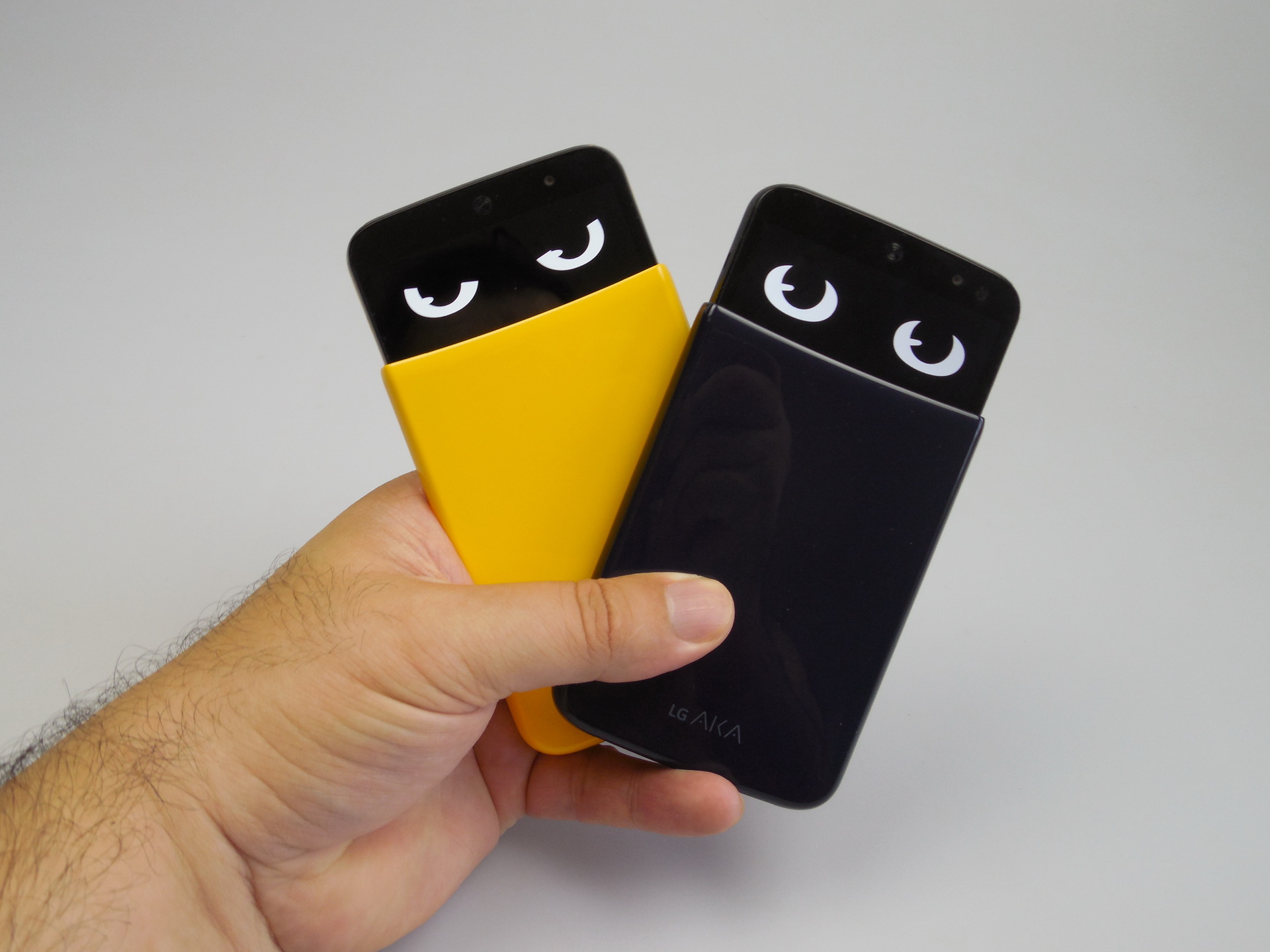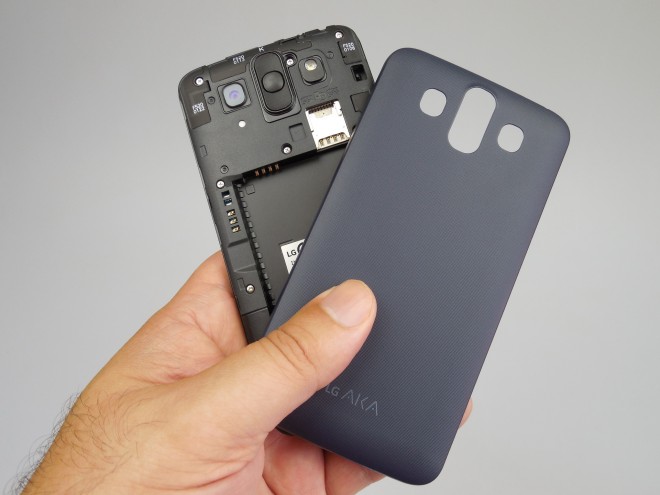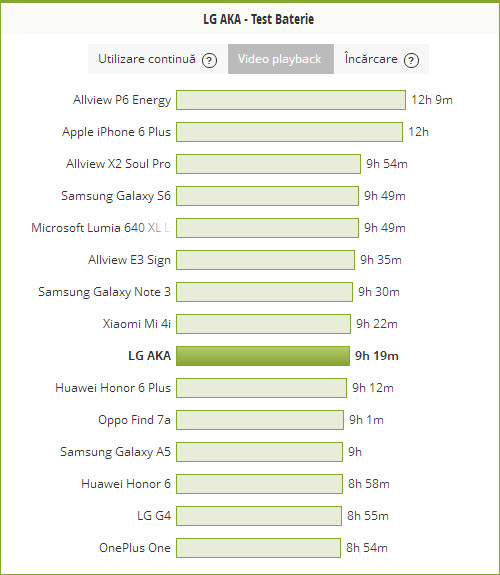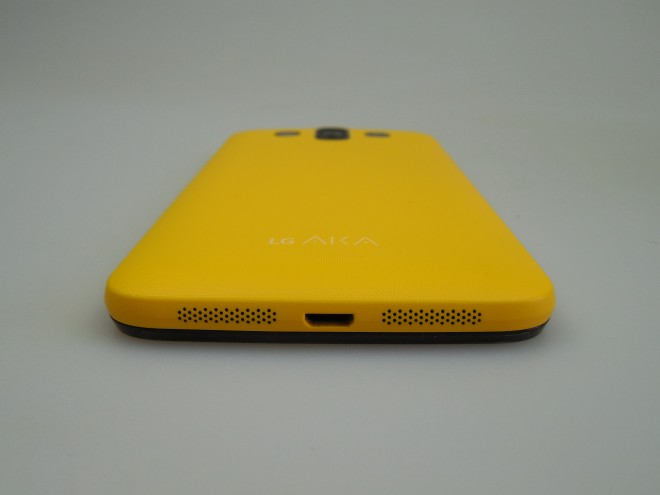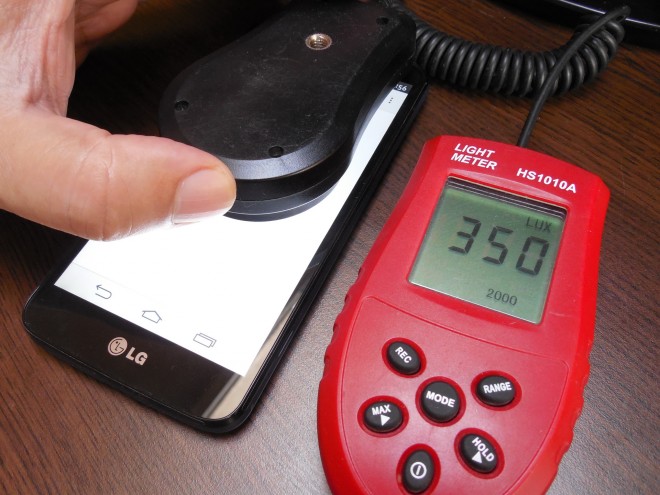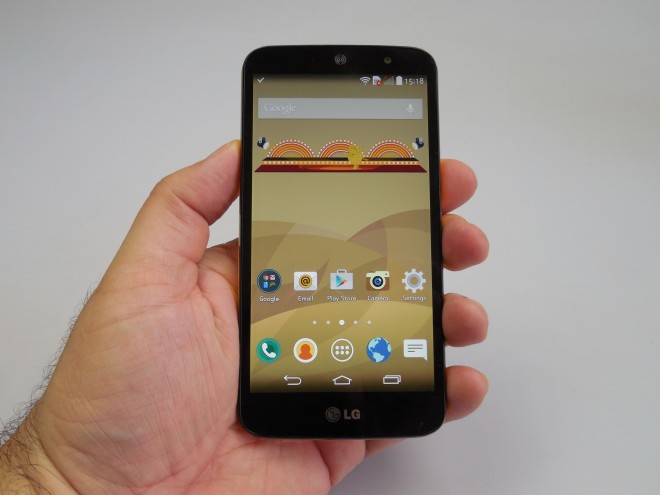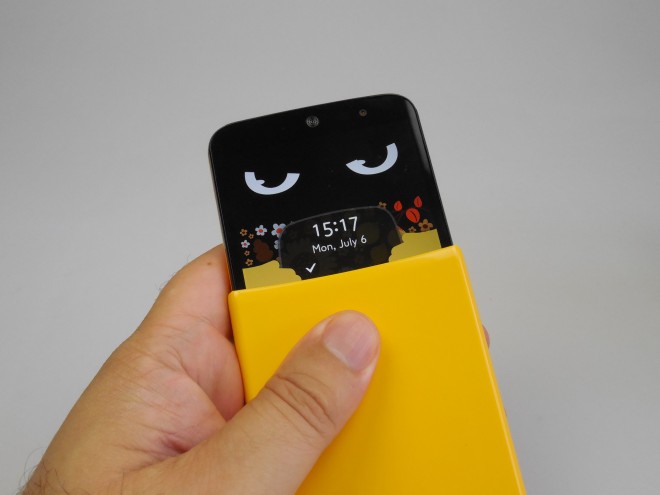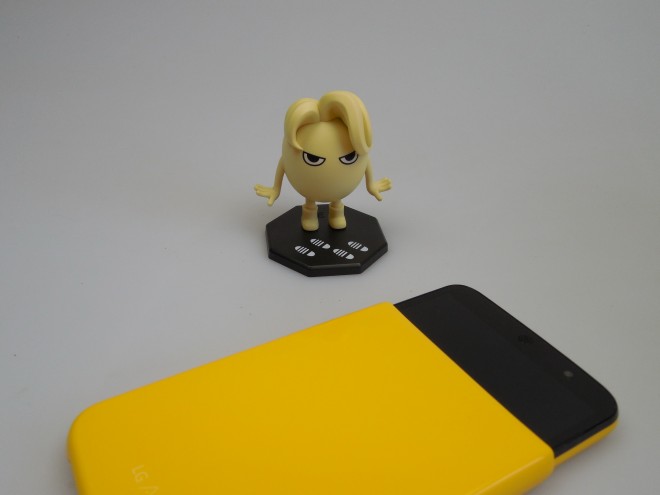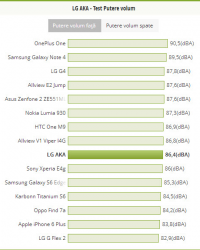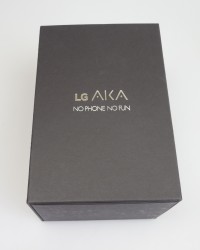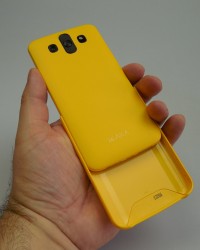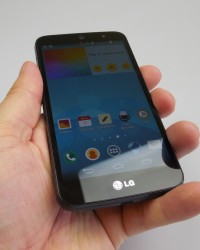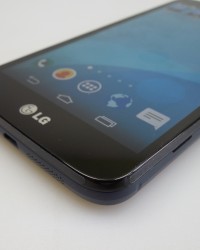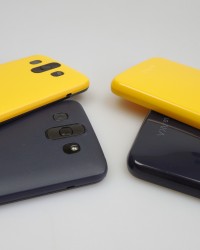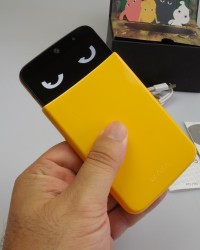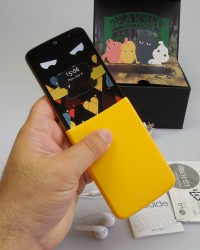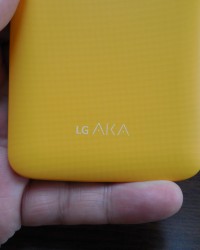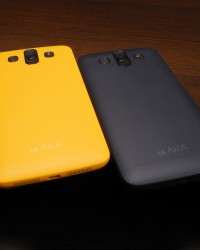It’s finally time to publish the finalized review of the LG AKA, one of the cutest and funkiest handsets we’ve tested this year. The smartphone has its own personality and a set of eyes to show for it. We had it in two versions, the yellow and blue one, both detailed below. Launched in South Korea last fall, this handset debuted in Europe in May and it comes with a case that triggers a pair of on screen eyes, plus a bundled mascot.
Priced at $240 on Amazon, the smartphone has 4 versions: white, blue, yellow and pink. It measures 9.9 mm in thickness, weighs 135 grams and it’s quite big for a 5 inch phone. Its case is made of plastic and tends to creak quite a bit. The same case has a dotted texture and the phone feels quite light and easy to use with one hand. Grip is good and the mascot bundled with the AKA comes in 4 guises.
There’s Eggy, a yellow little guy that falls in love a lot, Soul, the blue fellow who loves beer and music, Yoyo, the Pink one who’s always on a diet and craving and the Wooky, the white cool and crazy critter. There’s an external shell that activates the pair of eyes on the upper side of the screen and those eyes will be watching you with varied expressions. The same shell protects about 3/4 of the screen from scratches.
LG encourages placing stickers on the outer shell, by the way. Moving to the actual design analysis here, the device sports a small, round earpiece upfront, a front camera, sensors, status LED and a flossy facade. It also has big bezels and it’s a bit of a fingerprint magnet. The back side creaks when you touch it and holds the main camera, LED flash, laser autofocus mechanism, as well as the Power and volume buttons.
The back shell is easy to remove and it covers up the battery, microSIM and microSD card slot, with the latter two overlapped. The case of the phone feels a bit flimsy to be honest. The top side includes the audio jack and microphone and at the bottom we’ve got the speakers, microUSB and a grille, one for the microphone and one for the speaker. The sides hold a lanyard to the left and that’s about it.
LG AKA has a rather rounded design and it’s pretty comfy, but the creaking is annoying. I liked the shell that triggers those eyes, as a funky element and for the sake of protection. Moving on to hardware, the phone brings a 5 inch IPS display with a 1280 x 720 pixel resolution, a quad core Snapdragon 400 Cortex A7 processor, clocked at 1.2 GHz and the Adreno 305 GPU.
We also get 1.5 GB of RAM, 16 GB of storage and a microSD card slot that offers up to 32 GB in extra storage. At the back there’s an 8 megapixel shooter, with laser autofocus, while upfront we have a 2.1 megapixel camera. On the connectivity side there’s LTE Cat 4, WiFi a/b/g/n, GPS, Glonass, Bluetooth 4.0 and NFC, plus microUSB 2.0. There’s also an accelerometer and proximity sensor on board, while the battery inside the AKA is a Li-Ion 2460 mAh unit, that on paper provides 270 hours of standby functioning or 8 hours and 20 minutes of talk time.
In our test, that involves HD video playback in a loop, with WiFi on and brightness at 50%, we achieved 9 hours and 19 minutes, which is very good for a midranger. We beat the OnePlus One and its 8 hours and 54 minutes of playback, plus the LG G4 and its 8 hours and 55 minutes, as well as the Samsung Galaxy A5 and its 9 hours. Still, we scored below the HTC One M8 for example and its 10 hours and 15 minutes.
Then we did the PCMark test, that simulates continuous usage, with the brightness at 200 LUX, achieving a time of 6 hours and 22 minutes. We beat the LG G4 and its 5 hours and 19 minutes, as well as the Huawei P8 and its 5 hours and 31 minutes, but we scored below the Galaxy S6 and its 7 hours and 6 minutes. Overall, battery times are quite good here and the charging takes 2 hours and 8 minutes, which is OK.
We beat the HTC One M9 and its 2 hours and 20 minutes of charging, but we scored below the LG G Flex 2 and its 1 hour and 47 minutes. Overall, this is a very good battery in my book and you can tweak its functioning from the Settings. You can turn on Battery Saver at a certain percentage and turn off features like auto sync, Bluetooth, WiFi, reduce brightness and tweak screen timeout to save juice.
It’s now time to analyze the acoustics, beginning with the fact we’ve got a single speaker at the bottom of the device. The music player here resembles the one of the LG G3 and it’s quite minimal. It offers the option to find a music video and its options and settings also include a Sleep Timer, among others. Audio Effects are the EQ basically, but that’s only triggered for headphones.
You can change the pitch and speed of a song and the player is quite capable, offering FLAC and WAV file support. The listening experience revealed that the sound was pretty loud and clear, plus the bass was OK and the general feeling was that the sound was warm. Headphones are of the standard kind, made of plastic, with a tangling wire and not exactly fitting very comfily in the ear. They tend to fall off, but they have good bass and they’re loud and clear.
Since we are using headphones, the EQ is available and offers options like Normal, Bass Boost, Treble Boost or Vocal Boost. 7 custom channels are included and there’s no FM radio here. We did a decibelmeter test and achieved a value of 86.4 dBA for the LG AKA, which is good and it beats the LG G Flex 2 and its 82.9 dBA, plus the iPhone 6 Plus and its 83.8 dBA.
We did score below the Galaxy S6 and its 89 dBA, but still the result is good. Settings dedicated to the audio section include Profile Volumes, Quiet Mode, Ringtones, vibration type and special sound effects for screen lock, cover etc. Overall acoustics are good and we move on to the display. The screen is an IPS LCD 5 incher, with a 1280 x 720 pixel resolution and 294 PPI density.
The gallery serves as video player and there’s also Q Slide functionality, basically a sort of pop up play, plus the option to tweak screen ratio and subs. Pinch to zoom is enabled too. The viewing experience pointed out the oversaturated colors, good brightness and nice contrast, as well as wide view angles. Black are reasonably deep and the screen is overall quite good.
Pixels are of the RGB Stripe kind and during our test with a luxmeter, we achieved 350 LUX units, which is good for a midranger. We beat the LG G Flex 2, that achieved 266 LUX and the Huawei P8 with its 346 LUX, as well as the ASUS ZenFone 2 and its 323 LUX. Still, we scored below the Galaxy A5 and its 370 LUX, or the Wiko Rainbow and its 424 LUX.
Settings dedicated to the screen include Homescreen (with a special Easy setup), Theme, Lockscreen, Home Touch Button layout, font (type and size), brightness, notification LED and timeout. Smart Screen is also here plus screen off effect. Overall, the screen is good for a midranger, both crisp and bright. Now we turn our attention to the 8 megapixel back camera, with laser assisted autofocus and the front 2.1 MP shooter.
The whole laser AF thing helps with the low light focus, by the way. The UI is once again the same as the one of the LG G3, with basic options and the camera doesn’t start up very fast. On the left side of the screen we’ve got flash options, the front camera shortcut and Modes (Auto, Panorama). Then there are the Settings, that include HDR (On/Off/Auto) and resolution (8 MP, 6 MP or 5 MP). Video can be taken in Full HD or HD and there’s also a voice command option.
The list goes on with a timer and grid, while on the right side we find the Shutter button, video button and a Gallery shortcut. You can zoom up to 4X fluidly and the focus is quite fast here, but picture taking isn’t that fast. The front camera only brings a beauty slider as an extra. The gallery was taken around the end of June, on a sunny day and the camera faces the sun pretty OK.
HDR is able to decrease exaggerated brightness and generally the pictures had good colors. They came out clear and less burnt than I expected. Even when zooming into some shots, quality remained decent. Panorama is quite wide, at 15.936 x 1664 pixels and it was taken very fast and without artefacts. There’s also a nifty HDR of a faucet we did and colors very vivid pretty much in all shots, but also realistic.
Exposure, focus and white balance were also top notch and the closeup of that dragon toy thingie came out fine as well. Landscape shots looked reasonable and the flower macros made a good impression. We played with the focus bokeh style and even that worked out fine, beating our expectations. Good blues and yellows are a highlight you should remember here.
Overall, this 8 MP shooter can even pick a fight with some 13 MP shooters on several HTC Desire models for example. I’d go as far as to say this camera can take on the iPhone 5 and Galaxy S4 even. For a midranger it stands on its own and now let’s see the video capture. You can film in Full HD, MP4 format, at 29 FPS and with 17 Mbps bitrate. The first video we did handled the exposure change pretty OK, but had poor stabilization and its resolution felt lower than Full HD.
The second video was crisp, had OK details when zooming in, but also slight microphone problems in the wind. Colors were good. The third video had good acoustics, but also focus loss. At least the quality was OK. The fourth video had an OK focus, good exposure and colors, plus stabilization was decent this time around. Overall, I’d only label the filming as passable to good and this camera package is not bad at all for a midranger.
It’s not far from my own iPhone 5 experience to be frank. Editing is done here with the stock KitKat options and you can crop, rotate and use filters and frames. Moving on to performance, after playing the game Riptide GP2 for 15 minutes we reached a temperature of 38.4 degrees Celsius, so there’s no overheating here. The browser is not very fast, but also not very slow, stuck somewhere in the limbo of speed.
Sadly, the keyboard is not very well spaced and it’s rather narrow. The phone section brought us Speed Dial, one hand usage options, high volume and a clear and clean sound. Even some noise canceling made the cut. Now we get to the benchmarks, where we compared the LG AKA with the Wiko Rainbow and the Sony Xperia E4G. It’s a battle between a quad core Snapdragon 400 and 1.5 GB of RAM, plus a quad core MediaTek MT6582 and 1 GB of RAM, plus a 4 core MediaTek MT6732 and 1 GB of RAM.
Keep in mind that the CPU on the LG AKA, the Snapdragon 400 is a tad old, dating from 2013. Here are the results of the benchmarks:
Overall, the AKA wins 2 out of 11 tests, although the rivals are theoretically weaker in specs. There’s a bit of lag on the device, especially when you have a few apps open at the same time and immediately after the boot. Still, the 3D graphics game such as Riptide GP2 run just fine. The OS is Android 4.4.2 KitKat here, with the same UI styling as the LG G3. The UI is colourful and flat, plus not glossy. Icons are a bit flashy…
Multitasking is done with the aid of thumbnails, much like on HTC Sense (9 of them) and the widgets are not many in number and they’re a combo of stock Android ones and LG ones. If you keep an icon pressed you can change its pictogram, by the way. The dropdown area is crowded on the small screen, including notifications and Quick Settings in this area, plus 2 sliders (volume and brightness). Things can get a bit hectic there…
QuickMemo+ gets its own comfy shortcut, as well as Q Slide, that lets you overlap two apps in windows and use them at the same time. The Settings are pretty much typical, aside from the pointer speed one, cloud settings, one hand usage and the assigning of the back keys to app functionality. Then there’s Security and Guest Mode, as well as Gestures (flip to snooze, motion sensor calibration and double tap to wake).
Smart Cleaning is also performed from this area. And now we’ve gotten to that part of the review we call the “AKA Factor”. The thing is that if you change the plastic cover upfront, you also change the character you’re playing with. You have to tap on the phone’s eyes to wake up the “critter”, or shake the device to make him dizzy. Cover the eyes and quick lift your hand to play a game of hide and seek, or attach a pair of headphones in order to see the critter putting on a pair as well.
The level of battery charging is also signalled by the same virtual character, with various eye squinting and colors (red for 1%, up to 15% orange and from 16 to 99% in blue). You can also see your character sweating or icy, depending on the weather and it’s all in the eye expression and the virtual unseen face. Once you gently pull the cover off, by an inch or so, you’ll see a notification panel, with a custom UI, that looks cool and cute.
There you can see mails and texts at a quick glance, as well as images that you’d like to display from the gallery. Each AKA also has a dedicated widget showing your character drinking beer or dancing for example. If you tap it you’ll enter a special area with new features, like Snapshoot, basically selfies with your mascot virtually included. They can also move and do silly dances while taking the picture.
By the way, if you only have one toy and know other people with the rest of the characters, you can scan them and own them virtually. From the same area you can reach a series of video episodes showing the looney characters hanging out and having fun. LG AKA also offers a handy clip tray, that lets you access quickly a picture, phone number, link, music or video. And now we’ve reached the app list, the preinstalled ones. Here we have the Google suit, Calculator, Calendar, Chrome, File Manager, Maps, QuickMemo+, Remote Call, LG Smartworld, Tasks, Think Free Viewer, Update Center, Voice Recording, Weather and YouTube.
Luckily there’s not much bloatware here. Now let’s see the Pros and Cons of the device!
Here are the Pros:
the lid protects the screen
comfy
good battery
loud volume
bright screen
good camera
funky eyes and cute personality for each AKA phone
And the Cons:
creaking case
crowded UI (dropdown area mostly)
pricey
old processor
KitKat only and not updated yet
We give the LG AKA an 8.3 out of 10 for design, an 8.7 for hardware and a 9 for OS and UI. The final grade is 8.66 out of 10 and you should know that this model’s popularity is based more on marketing than anything else. It’s not about the features, but more about the kids demanding you get an AKA, in Happy Meal fashion. It’s still an unique package for a phone, but the whole concept can be updated much further in the future, so we expect more functionality.

